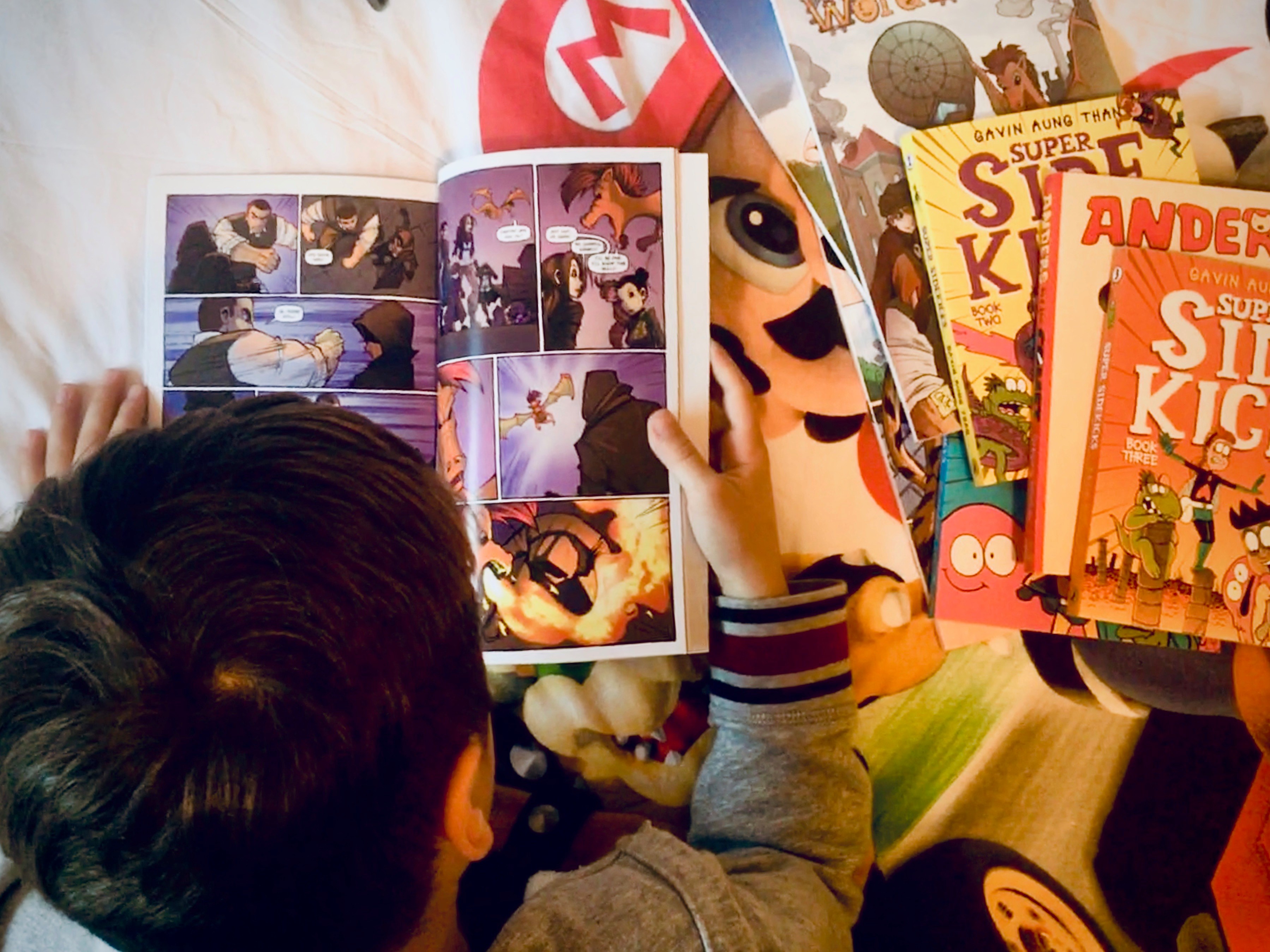Issue 115
Term 4 2020
21st-century literacy with graphic novels
Iurgi Urrutia, librarian and ALIA Graphic Novels and Comics Convenor, explores the power of graphic novels.

Reading is reading
We read books, newspapers, magazines, billboards, signs, notices, bills, websites, blogs, social media posts et cetera. When we read all those things, consciously or unconsciously we’re developing and using multiple literacy skills. Thanks to the internet and social media, we’re also increasingly relying on visual literacy and multimodal texts.
Comics have long suffered a stigma that is unfortunately frequently reiterated by teachers, parents and librarians. A child is reading a comic or wants to borrow one and a well-meaning grown up says, ‘Pick a real book. Do some reading.’ Every time this happens enormous damage is done, with children being turned away from reading the books that pique their interest.
A comic – a graphic novel – is sequential art. But what is the harm in that? Reading is reading and it is a well-known fact that children who read for fun and find pleasure in reading become lifelong readers. So let’s fight the stigma and discuss some of the literacy superpowers that can be gained by reading comics.
The power of comics
Comics come in all shapes, forms and genres. It is all too common for people to think of superheroes on hearing the word ‘comics’. However, the most popular and best-selling comics for young readers today are Raina Telgemeier’s humorous and heart-warming slice-of-life graphic novels, where she shares some of her life struggles, and Dav Pilkey’s Dog Man. As an English teacher noted, among all the fun and silliness of Dog Man: Lord of the Fleas, one page featured the words ‘shun’, ‘redundancy’, ‘eschew’, ‘reiteration’ and ‘recapitulation’.
We know that comics are attractive to children. They appeal to them because of their visuals; however, we also understand that comics are multimodal texts where the reader needs to use multiple literacies to make meaning. Think about the Dog Man words mentioned earlier. These are very high-level, but the power of comics makes them easier to understand as readers can infer meaning from the images.
Comics are an excellent resource for educators because they engage struggling readers with a visual allure.
It is this perfect blend of the written word and visual narrative – with the added bonus that readers are in complete control of the experience – that makes comics incredibly rich and complex texts. Novels offer no visuals. Movies offer visuals but no words and a viewer has no control over the pace of viewing. With comics, words and visuals complement and enrich each other. Even better, readers are in complete control of what they focus their attention on and how quickly or slowly they decode and read the text.
Multiple-literacy superpowers
Borrowing and adapting the New London Group’s multiliteracy model from 1996, five literacies that readers have to use when reading comics are:
- linguistic (written language)
- visual (mood through colours, shading, composition et cetera)
- gestural (body and facial language)
- spatial (panels, layout …)
- symbolic (icons, balloons, visual representations and emanata).
In order to make meaning, the reader has to look at all of these elements, decode and interpret them, and then combine them all to make meaning. It may be argued that by combining all of these elements, the reader is working much harder than when reading a book or watching a movie. Best of all, studies have shown that readers benefit from greater information retention because they have to decode so many different elements using multiple literacies. This is why graphic novels are increasingly being used in classrooms, including in tertiary education.
Reading is reading and it is a well-known fact that children who read for fun and find pleasure in reading become lifelong readers.
Additionally, comics model some excellent literacy practices for readers, such as:
- precise, concise and rich language (Jaffe 2014)
- visuals supporting and strengthening memory recall with higher neural connections (Jaffe 2014)
- a higher incidence of median words and rare words than junior fiction, comparable to adult fiction (Center of Teaching and Learning)
- learning complex non-verbal communication (Kullberg 2018; Jaffe 2014).
Comics demand the writer to be concise. They don’t have long paragraphs and the constraints of the page demand that narration and dialogue are kept to a minimum. No word can be wasted, which forces the writer to be incredibly precise with the written word. This models excellent writing and offers rich vocabulary because every word matters.
Comics also offer a rich visual narrative with a multitude of tools for the artist to create meaning, for instance the shape of the panels, the colouring, the lines, the number of panels on the page, the shape of the speech balloons and emanata. They’re all elements the reader decodes to infer meaning. This is a complex task because often the visuals act as metaphors or contradict the text, forcing the reader to decode and establish their relationships.
In summary, comics are an excellent resource for educators because they engage struggling readers with a visual allure. They encourage reading because they don’t seem as daunting as a whole book filled with words. Comics help early readers to decode text with visual elements providing clues to support the reader. More importantly, comics extend the reading for advanced readers with the interaction of the written and visual narratives adding complex layers of meaning.
There are some great reasons for reading comics and graphic novels and they’re incredibly popular right now. Young readers are devouring Dav Pilkey, Raina Telgemeier and Aaron Blabey’s works (among many others). In fact, Pilkey’s Dog Man was the third best selling book in the US last year, despite coming out in July, and Raina Telgemeier’s Guts was in the top 15 despite coming out in October. Australian Aaron Blabey’s Bad Guys books have been in the NYT Best Seller list for more than a year.
Hollywood and TV studios are adapting an enormous number of comics for the screen, but best of all, some of the most amazing, personal, independent and diverse titles being published right now are coming out as graphic novels. School curriculums are placing increasing emphasis on visual literacy and there is no doubt that the old stigma must be cast into the dustbin of history by librarians and teachers. The time to embrace the rich variety and depth that graphic novels have to offer is now!
